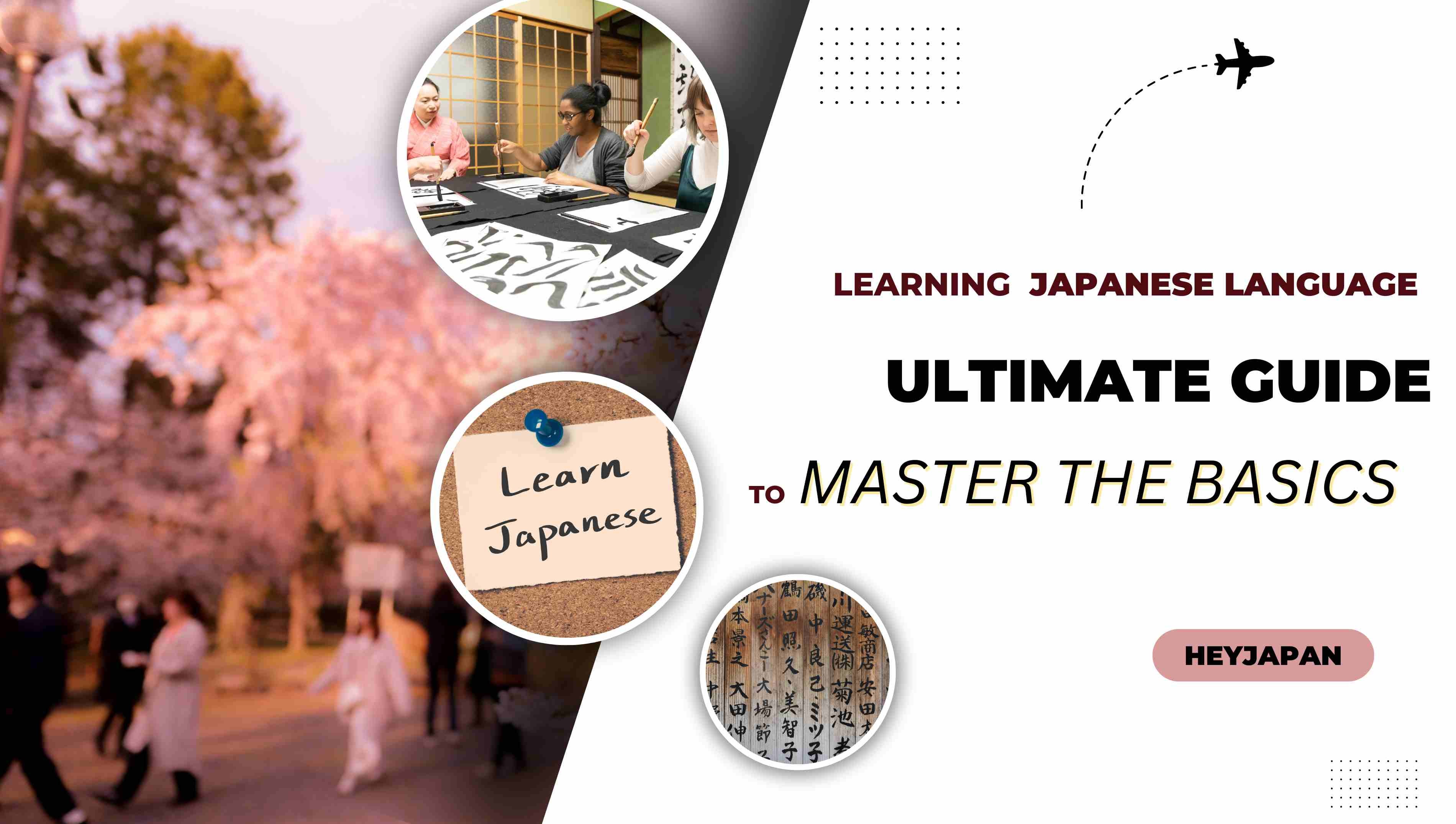- 1. Introduction: Why Learn Japanese?
- 2. Basic Japanese
- The Japanese Writing System
- Pronunciation and Phonetics
- Basic Grammar Structures
- 3. Practical Japanese knowledge
- Asking Questions and Seeking Directions
- Expressing Likes, Dislikes, and Preferences
- Ordering Food and Dining Etiquette
- Transportation and Travel Phrases
- Conclusion
- FAQs
Embarking on the journey of learning a new language is a thrilling and enriching endeavor, and Japanese is a language that holds endless fascination. Whether you find yourself captivated by the allure of Japanese culture, eagerly planning a future visit to Japan, or simply seeking to broaden your horizons, this comprehensive guide is your passport to mastering the fundamental elements of the Japanese language. By following this self-study guide, you'll be well on your way to unlocking the wonders of the Japanese language.
1. Introduction: Why Learn Japanese?
Learning Japanese offers a multitude of benefits. Japan has a rich cultural heritage, and understanding the language allows you to delve deeper into its traditions, literature, and arts. Additionally, Japan is a prominent global economic power, and knowing the language can open up exciting career opportunities. Whether for personal or professional reasons, learning Japanese is a valuable investment.
2. Basic Japanese
The Japanese Writing System
Japanese employs three writing systems: Kanji, Hiragana, and Katakana. Kanji consists of Chinese characters and represents the meaning of words. Hiragana is used for native Japanese words and grammatical particles, while Katakana is primarily used for loanwords and foreign names. Understanding and practicing these writing systems is essential for effective communication in Japanese.

Studying hard is a reasonable way to conquer Japanese
Pronunciation and Phonetics
Mastering the pronunciation and phonetics of Japanese is crucial for clear and accurate communication. Paying attention to the different sounds and intonation patterns will help you sound more natural when speaking. Practice listening to native speakers, and make use of resources that provide audio samples to refine your pronunciation skills.
Mastering the pronunciation and phonetics of Japanese is crucial for achieving fluency and effective communication. Here are some approaches to help you improve your Japanese pronunciation:
Mimicking Native Speakers: One effective method is to listen carefully to native Japanese speakers and imitate their pronunciation. Pay attention to their intonation, pitch, and rhythm. You can watch Japanese movies, TV shows, or listen to Japanese podcasts to expose yourself to authentic spoken Japanese.
Reference: Use resources like Forvo (www.forvo.com) or Rhinospike (rhinospike.com) to listen to native speakers pronouncing specific words or phrases.
Practicing with Minimal Pairs: Focus on distinguishing similar sounds in Japanese by using minimal pairs. Minimal pairs are words that differ by only one sound. By practicing these pairs, you can train your ears to identify subtle differences in pronunciation.
Example: Practice distinguishing the "r" and "l" sounds in Japanese, such as "ramen" (らめん) and "ramen" (られん).
Reference: The book "Japanese Pronunciation Exercises for Communication" by Shinji Higuchi provides a comprehensive collection of minimal pairs for practice.
Utilizing Pronunciation Guides: Many textbooks and online resources provide detailed guides on Japanese pronunciation. These resources break down the sounds of the language and offer step-by-step instructions on how to produce them correctly.
Reference: The website Tae Kim's Guide to Learning Japanese (www.guidetojapanese.org) provides a comprehensive section on pronunciation, including detailed explanations and audio samples. You can also use HeyJapan's Shibi Talk feature - a basic Japanese self-study app to practice speaking.
Seeking Feedback: Practice with a native Japanese speaker or language exchange partner who can provide feedback on your pronunciation. Regularly speaking with a fluent speaker allows you to identify and correct any errors or mispronunciations.
Example: Join online language exchange platforms like HelloTalk (www.hellotalk.com) or Tandem (www.tandem.net) to connect with Japanese speakers for language practice and feedback.
Remember, consistent practice and patience are key to mastering Japanese pronunciation. Embrace the process, actively listen to native speakers, and utilize the available resources to refine your pronunciation skills.
Basic Grammar Structures
Understanding the basic grammar structures is fundamental to constructing meaningful sentences in Japanese. Focus on topics like verb conjugation, noun-adjective agreement, and sentence particles. Study textbooks, online tutorials, or join language exchange groups to practice and reinforce your understanding of Japanese grammar.
3. Practical Japanese knowledge
Asking Questions and Seeking Directions
Asking questions and seeking directions is an important skill when navigating through Japan. Learn how to ask for directions, inquire about locations, and understand responses. Practice scenarios that involve asking for recommendations, getting travel information, and interacting with locals.
Here are five useful phrases for asking questions and seeking directions in Japanese:
- どこですか? (Doko desu ka?) - "Where is it?" This phrase is helpful when you want to ask for the location of a specific place or object.
- ~はどこですか? (-wa doko desu ka?) - "Where is the ?" You can insert the name of a specific location or landmark in place of the ? to inquire about its whereabouts.
- ~に行く方法は何ですか? (-ni iku hōhō wa nan desu ka?) - "What is the way to go to ~?" Use this phrase to ask for directions to a particular destination or to inquire about the route to get there.
- すみません、道に迷ってしまいました。助けてください。 (Sumimasen, michi ni mayotte shimaimashita. Tasukete kudasai.) - "Excuse me, I'm lost. Can you help me?" If you find yourself lost and need assistance, this polite phrase will come in handy to seek help from locals.
- 何処で食事ができますか? (Doko de shokuji ga dekimasu ka?) - "Where can I have a meal?" When you're looking for a place to eat, use this phrase to ask for recommendations or directions to nearby dining options.
Expressing Likes, Dislikes, and Preferences
Being able to express your preferences, likes, and dislikes adds depth to your conversations. Learn vocabulary related to hobbies, activities, and interests. Practice discussing your favorite things and expressing opinions in a polite manner.
Here are five useful phrases for expressing likes, dislikes, and preferences in Japanese:
- 好きです。 (Suki desu.) - "I like it." This simple phrase is used to express that you have a positive preference or liking for something.
- 嫌いです。 (Kirai desu.) - "I dislike it." When you want to express that you have a negative preference or dislike for something, you can use this phrase.
- ~が好きです。 (-ga suki desu.) - "I like ___ " Insert the name of a specific thing or activity in place of the ____ to express your liking for it.
- ~が嫌いです。 (-ga kirai desu.) - "I dislike ___" Similar to the previous phrase, you can insert the name of a specific thing or activity in place of the ____ to express your dislike for it.
- ~が一番好きです。 (-ga ichiban suki desu.) - "I like ~ the most." Use this phrase when you want to express a strong preference for something, indicating that it is your favorite among others.
Ordering Food and Dining Etiquette
Japan is renowned for its unique culinary delights, and understanding how to order food and navigate dining situations is essential. Familiarize yourself with common food-related vocabulary, phrases for ordering, and dining etiquette. When visiting Japan, understanding the basics of ordering food and observing dining etiquette can greatly enhance your dining experiences.

Japanese food
Here are some key points to keep in mind:
- Greeting: It is customary to greet the staff upon entering a restaurant with a polite "Irasshaimase" (Welcome). This shows respect and sets a positive tone for the interaction.
- Seating: In many traditional Japanese restaurants, you may be asked to remove your shoes before entering the seating area. Follow the lead of the staff and observe if there are specific seating arrangements, such as sitting on tatami mats or at a counter.
- Menus and Ordering: Japanese menus often showcase a wide variety of dishes. If you need assistance, you can politely say, "Sumimasen, o-susume wa nan desu ka?" (Excuse me, what do you recommend?). Additionally, it is common to use the suffix "-kudasai" when ordering, such as "Kore o kudasai" (Please give me this).
- Table Manners: Japanese dining etiquette emphasizes cleanliness and respect for food. It is customary to say "Itadakimasu" before starting a meal, which expresses gratitude for the food. Remember to use chopsticks appropriately, avoiding crossing them or sticking them vertically in the rice.
- Sharing and Tasting: Sharing dishes with others is common in Japan. When dining with a group, it is polite to offer a small portion of your dish to others by saying, "Dozo, tabete kudasai" (Please have some). If someone offers you a taste of their dish, respond with "O-sorosoro" (Thank you) or "Chotto itadakimasu" (I'll have a little).
- Paying the Bill: When it comes time to pay the bill, signal the staff by saying "O-kanjo onegaishimasu" (The bill, please). It is common for the staff to bring the bill to your table. To split the bill, you can ask, "Betsu betsu de onegai shimasu" (Separate, please).
Remember, these are general guidelines, and specific customs may vary depending on the type of establishment. Observing and respecting local customs will leave a positive impression and enhance your dining experience in Japan.
Example dialogue:
Customer: Sumimasen, o-susume wa nan desu ka? (Excuse me, what do you recommend?) Waiter: Kore wa tori no teriyaki desu. Oishii desu yo. (This is chicken teriyaki. It's delicious.) Customer: Kore o kudasai. (Please give me this.)
Waiter: Hai, doomo arigatou gozaimasu. (Yes, thank you very much.)
Customer: Itadakimasu! (I humbly receive.)
By familiarizing yourself with these dining customs and using simple Japanese phrases, you can navigate the ordering process and enjoy a culturally immersive dining experience in Japan. This knowledge will enhance your dining experiences and help you appreciate Japanese cuisine to the fullest.
Transportation and Travel Phrases
Navigating transportation systems in Japan can initially seem daunting, but with practice, it becomes more manageable. Learn vocabulary related to public transportation, train stations, and airports. Practice common travel phrases for asking directions, purchasing tickets, and seeking information.
Here are some useful transportation and travel phrases in Japanese:
Asking for Directions:
Sumimasen, eikyūsha wa doko desu ka? (Excuse me, where is the train station?)
Michi o kudasai. (Please give me directions.)
Taking a Taxi:
Takushii o onegaishimasu. (I would like a taxi, please.)
Tōkyō Eki made onegaishimasu. (Please take me to Tokyo Station.)
Using Public Transportation:
Ikura desu ka? (How much does it cost?)
Kippu o kudasai. (Please give me a ticket.)
At the Airport:
Pasupōto o motte imasu ka? (Do you have a passport?)
Kono baggu o totemo ii desu ka? (Can I carry this bag on board?)
Booking Accommodation:
Yoyaku o shitaidesu. (I would like to make a reservation.)
Heya ni netsubyou ga arimasu. (There is a problem with the room.)
At the Train Station:
Kippu-uriba wa doko desu ka? (Where is the ticket counter?)
Kono eki kara doko made ikimasu ka? (Where can I go from this station?)
Inquiring about Schedules:
Kono basu wa nan-ji ni demasu ka? (What time does this bus leave?)
Kono densha wa nankai-sen desu ka? (Is this train bound for Nankai?)
Seeking Assistance:
Tasukete kudasai! (Please help me!)
Eigo o hanasemasu ka? (Do you speak English?)
Remember to speak politely by adding "kudasai" (please) at the end of your requests. Practice these phrases to confidently navigate transportation and travel situations in Japan.
Conclusion
Learning the basics of the Japanese language opens up a world of opportunities. By following this ultimate guide, you have equipped yourself with the necessary tools and knowledge to embark on your Japanese language journey. Embrace the learning process, practice regularly, and immerse yourself in Japanese culture. Remember, mastering any language takes time and dedication, but with perseverance, you can achieve fluency in Japanese and enjoy the numerous benefits it brings.
FAQs
1. How long does it take to learn Japanese?
The time it takes to learn Japanese varies depending on various factors, such as your prior language learning experience, study routine, and the level of fluency you aim to achieve. However, with consistent effort and practice, you can make significant progress within a year or two.
2. Are there any online resources to learn Japanese for free?
Yes, several online platforms offer free resources for learning Japanese. Websites, mobile apps, and YouTube channels provide lessons, vocabulary exercises, and interactive tools to aid your language learning journey.
3. Can I learn Japanese without a tutor or attending classes?
Yes, self-study is a viable approach to learning Japanese. With the abundance of resources available online, you can acquire language skills through textbooks, language learning apps, online tutorials, and language exchange platforms.
4. How can I practice speaking Japanese if I don't have native speakers around?
Even without native speakers nearby, you can practice speaking Japanese through language exchange programs, online communities, language learning apps with voice recognition features (like HeyJapan and Dualingo), or by hiring an online tutor for conversation practice.
Now that you have your comprehensive guide to learning Japanese, it's time to embark on your language learning journey. Remember, consistency and dedication are key to mastering any language. Ganbatte (good luck) as you explore the fascinating world of the Japanese language!
Learn basic Japanese with HeyJapan
iOS: https://apps.apple.com/us/app/heyjapan-learn-basic-japanese/id1576311051
Android: https://play.google.com/store/apps/details?id=com.eup.heyjapan









